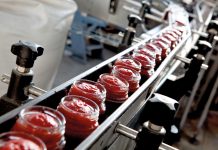 Food companies require versatility, efficiency and safety to labelling and coding systems. In addition, they must be able to adapt to existing production lines, packaging machines and different types of packaging. The issue of the release of substances from inks to food is now topical.
Food companies require versatility, efficiency and safety to labelling and coding systems. In addition, they must be able to adapt to existing production lines, packaging machines and different types of packaging. The issue of the release of substances from inks to food is now topical.
Food companies must always keep up to date with the changes in regulations imposed by the European Community, Italy and large scale retail trade. Also in the area of labelling and coding, there is binding information that must be printed on primary, secondary and pallet packaging. In addition to the information required by labelling regulations, i.e. lot numbers, expiry or best-before date, weight, etc., there are also GTIN and SSCC codes.
The Global Trade Item Number (GTIN) is used to identify products and packages around the world, to sell them in organized trade and online (Amazon, eBay, Alibaba, Google Shopping). The Serial Shipping Container Code (SSCC) is a logistics standard used in the supply chain to identify each loading unit entering or leaving the warehouse. This identification system allows a complete logistical traceability, since it allows to individually know all the shipment data and the exact contents of the loading unit, regardless of the container.
These are therefore very important numerical codes which must be permanently imprinted on the packaging. Food production lines are often hostile environments for labelling and coding machinery due to humidity, low or high temperatures, washing and sanitizing procedures. Food companies require versatility, efficiency and safety to labelling and coding machinery.
The marking and coding systems must be able to adapt to the existing production lines, with the packaging machines and their high speeds, to the different types of packaging that the company uses for its products, guaranteeing a precise and constant marking over time. Some solutions are integrated in the production line before or after the package filling phase or into the labelling system. These must be reliable, with low running costs, little maintenance and easy to use. Production line stops could compromise the wholesomeness of fresh and delicate food products and increase production costs.
 Labelling and coding system
Labelling and coding system
Food companies have a variety of coding technologies available: Ink jet markers, laser markers, electrical stamping machines, hot markers. Systems must be flexible and capable of printing on different types of packaging and materials: Rigid packaging, eggs, poly-coated cardboard, PET bottles, plastic and aluminium trays, glass and tin-plate packaging etc. Ink jet markers are characterized by the speed of marking on any smooth or uneven surface and integrate well into existing production lines.
They are also used for micro-character encoding of products and packages. Thanks to a high-pressure pump, a continuous flow of ink drops is created, which, through a magnetic field, mark the packaging, while unused drops return to the hydraulic circuit to be reused and minimize consumption. The printing is contactless, fast and durable. Built-in displays show the print image that can be set as required and stored. Co2 laser markers engrave and cut various materials (bottles, organic materials, glass), even with thicknesses of several millimetres.
Thermal transfer printers allow the printing of text, data and graphics, such as bar codes, expiration dates, lot numbers, prices, etc. They can be easily integrated into filling and sealing systems, labelling and thermoforming machines. Thermal Transfer Overprinters (TTO) use a heated print-head that deposits ink on the surface in real time during the production process. Thermal printers allow high-quality printing on different formats and substrates while maintaining excellent yield and durability. They are suitable for high-performance self-adhesive labels, even with frequently changing data.
They are flexible and versatile models that can be used on different types of packaging. The most commonly used labelling systems are automatic labelling systems that allow front, side, top, bottom and seal labels to be applied to products. Manual and semi-automatic label applicators work well for small companies. There are also pick&place manipulators for packaging in thermoformed trays, flow-packs, boxes made of non-porous material, but also automatic print&apply systems, and high-quality printers of bar codes, images and texts.
The automatic industrial labellers are machines dedicated to the application of self-adhesive labels, i.e. seal labels, multi-pack labels, stretch film, eggs, blow-fill-seal, of different widths with high application frequencies, maintaining control over precision. It is possible to manage multiple functions at the same time, optimizing working times, but also saving energy by interrupting power consumption in the event of prolonged inactivity. Many machines are designed to warn the operator in case of end of roll, jam, end of label, etc. In some models it is possible to install hot, thermal transfer or ink-jet printing units, to have more possibilities of operational choice depending on the application requirements.
There are also systems for labelling, coding and tracing that make use of vision and rejection of non-compliant products. Food companies also use automatic sheeters for the picking and distribution of leaflets, coupons, stickers, mini gift items, neck collars on bottles and jars, large sheets and heat-sealed pouches. These machines operate at high speeds and integrate well into high-precision production lines. Manual or semi-automatic label applicators are characterized by compact dimensions and are used for the application of self-adhesive seal, front and back labels , or top and bottom labels on pre-formed boxes.
Print&apply systems are used for real-time printing of bar codes, images and other data and for contactless application of the last printed label onto stationary or moving products or packages. The most advanced systems are equipped with automatic devices capable of detecting the correct distance from the surface and thus adapting the stroke of the applicator pad accordingly. In some machines, an air-jet applicator allows the labels to be attached by sucking and depositing them on the front and side of the stationary pallet.
 Inks for food packaging
Inks for food packaging
A separate chapter is deserved to inks for food packaging, developed to avoid any risk of contamination of products with so-called NIAS (non-intentionally added substances). The European Printing Ink Association (EuPIA) has issued guidelines on “Good Manufacturing Practices: Printing Inks for Food-Contact Materials” published in 2008 and updated in 2016. As stated on the association’s website, EuPIA guidelines have been designed “to help control of food safety hazards during the design and manufacture of inks, paints and surface coatings intended for application on food-contact materials, and formulated for use both not in contact with food and in direct contact with it.
Products developed and manufactured in accordance with GMP are intended to help food-packaging manufacturers provide the food industry with products that comply with the European legislation for materials and articles intended for food contact (MOCA), such as the Framework Regulation (EC) 1935/2004, and the so-called GMP Regulation (EC) 2023/2006”. The guidelines cover both inks in direct contact with food and inks not in direct contact with food. In the first case, the ink is applied to the surface that is in direct contact with the food or is expected to be in contact with it.
There is a very high potential risk for migration into the food of ink components/surface coating/paint, given the short distance the ink components have to migrate into food. There is also a type of short-term or incidental contact with the food, in which, although there is a contact, the shortness of the contact means that the potential of migration is lower than in the case of continuous contact. Inks that are not in direct contact with food are also a subset of the MOCA inks, where ink is applied to the non-contact surface of a food package. There is, however, a potential migration risk of ink components/surface coating/paint migration into food.
Some food manufacturers refer to the “Swiss List”, a list of safe components for food inks, which is allowed to be used on food-grade packages. The risk of inks being transferred to food from packaging is high, leading to health risks, as revealed in a survey conducted by Altroconsumo in 2019. The analyses were carried out on pure food board and on single-use products such as plates and paper cups. 76 products were analysed in four European countries: Italy, Denmark, Norway and Spain.
Two types of substances contained in inks that may be harmful to humans were investigated: Primary aromatic amines, considered to be carcinogenic and mutagenic, and different types of photoinitiators, used to give brightness to colours, but potentially carcinogenic or capable of influencing the endocrine system. The researchers took as parameters the Swiss law on the use of inks for food packaging and the opinion of the German Federal Institute for Risk (Bfr) regarding the risk of migration of primary aromatic amines to food. 45 samples were found to be compliant, i.e. they do not transfer hazardous chemicals from packaging to food. Others, however, have shown risks, confirming that the issue of the release of substances from inks to food is very topical.



